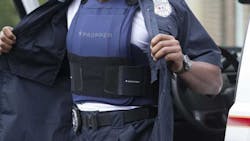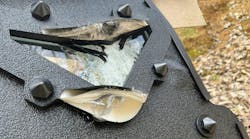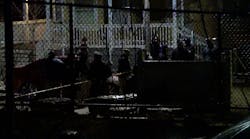Content Provided by Propper
Body armor has come a long way since the early days of heavy steel plates and metal gauntlets. Today’s armor is much more user-friendly and designed not only with the wearer in mind, but also for what the wearer will be doing in the armor. It’s lighter, yet stops a wider range of bullets and projectiles than ever before.
But even with all the advances in armor technology, the two biggest age-old concerns remain: fit and protection. Does it fit right and will it protect? And does it matter whether it’s a two-piece or four-panel vest? When it comes to both, the four-panel has clear advantages.
Fit
Two trouble spots with armor fit are range of motion and sitting down. Officers move a lot during a shift. From getting in and out of patrol vehicles to kneeling to render aid to chasing suspects, how armor fits affects every movement. Bulky two-piece vests tend to ride up against the throat and get in the way, resulting in constantly adjusting the vest throughout the shift. The fit can also affect the way an officer moves outside the vehicle, such as drawing from a hostler or aiming. At the very least, this is ultra-annoying. Worse, it can discourage officers from wearing it altogether.
The two-piece clamshell design was the standard for the first 40 years of soft body armor production. It was easy to make and easy to take on and off. But it was far from easy to wear. In fact, it’s one of the biggest reasons some officers don’t wear armor on the job. From the weight to the bulk to being hot in the summer, armor adds another layer to an already decked out uniform. And an ill-fitting vest makes it worse.
Officers come in a range of sizes, from slim and trim to some with a little more girth and every size in between. Each body type is different and poses its own unique challenges when it comes to fitting the correct size body armor. This is why all armor, regardless of design, needs to be custom sized to the individual wearer. A two-piece design offers very limited customization, with only front and back panels sized to fit the original user at time of purchase. If the officer gains or loses weight or the vest is transferred to another wearer, the side gap could shrink or expand, causing either added vulnerability or uncomfortable and bulky overlap. Both are bad.
A four-panel design, however, can be custom sized all the way around, including custom cummerbunds that fit exactly where the officer needs them, closing the gap left by a two-piece vest. Because the cummerbunds are independently adjustable and replaceable, they can be switched out without buying a whole new vest. Officers are more likely to wear a vest that fits wells, and the cummerbunds hold the front and back panels together better than conventional straps, helping the vest fit better under a uniform shirt. And thanks to independent movement, the vest is less likely to ride up under an officer’s chin when sitting.
Protection
Officers want to feel confident in body armor protection, knowing it will be there in time of crisis, which often happens in the blink of an eye. They don’t want to worry about whether their vest will work as promised. In fact, they don’t even want to think about it. Which is why the area of protection is critical.
The two-piece clamshell design fully covers front and back, but panel overlaps on the sides can leave coverage gaps. This design works great if shots are fired from straight in front or straight behind but puts the officer at risk for shots fired from odd directions or if the officer turns during an armed confrontation.
The introduction of the four-panel vest solved the side vulnerability issue that plagues the clamshell design by adding adjustable side cummerbunds that cover the gaps with the same ballistic material as the front and back. An officer who turns during a fight, such as to engage a second suspect or move to better cover, now has the same level of protection all the way around. And because the side panels are independently adjustable and replaceable, different sized officers still benefit from the added side panel protection.
Until recently, the four-panel design was only found in tactical vests and plate carriers. But now Propper offers the 4PV and 4PV-FEM concealable soft armor for patrol officers.
Shootings don’t happen in sterile, controlled environments. There is no guarantee attacks will only come from in front or behind. Stay comfortable and protected all the way around with a four-panel vest, protection for the 21st century.



